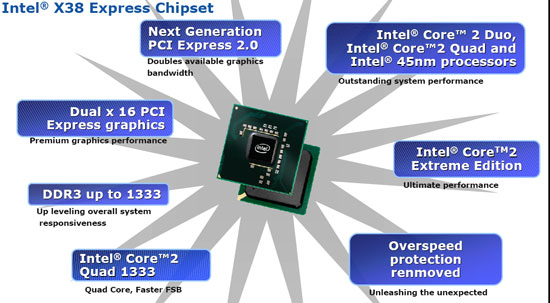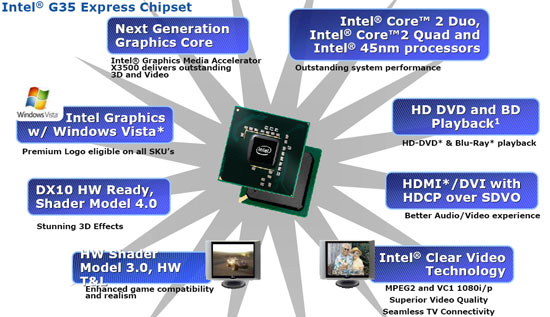Intel P35: Intel's Mainstream Chipset Grows Up
by Gary Key & Wesley Fink on May 21, 2007 3:45 PM EST- Posted in
- CPUs
X38 and G35 Chipsets - 3rd Quarter
While the X38 replacement for the 975X chipset will not launch until the 3rd quarter, Intel did provide enough information to make us wish it were here today. In addition to the feature enhancements on today's P35 chipset, X38 will add several unique features.
X38 will be the only Intel 3 series chipset to fully support dual x16 PCIe graphics. It was interesting that Intel did not specify CrossFire graphics in their literature, but we don't want to read too much into what wasn't said. The X38 will also be the first chipset to support PCI Express 2.0, which will replace the current PCIe standard. The other intriguing feature is something Intel calls "removing overspeed protection". This apparently refers to the fact X38 that will not have artificial bus speed limits on the chipset. We have seen what appeared to be artificial speed limits on Intel chipsets in the past, and an Intel chipset that can be pushed without artificial speed limits will be welcomed by all computer enthusiasts.
Other X38 features appear to be common to the P35 chipset, including full support for the 1333 processor bus and 1333 memory. X38 will also support all existing Intel processors and upcoming Penryn 45nm processors, just like other Intel Series 3 chipsets. X38 may also support other processor offerings, but Intel is not saying anything about that at this point.
G35
The third quarter will also see the introduction of Intel's G35 chipset, which will be Intel's most advanced integrated graphics chipset to date. While this may not be of huge interest to our readers, please keep in mind that the vast majority of computers sold today include integrated graphics. The G35 will be a very big deal for Intel and will be closely scrutinized by large-volume OEMs.

The G35 will be based on Intel's next-generation X3500 Graphics Media Accelerator. Full DX10 support is claimed, including support for Shader Model 4.0. For backwards compatibility X3500 also will support Shader Model 3.0 and Hardware Transform and Lighting (T&L). High Resolution DVD playback is also featured, with support for both HD-DVD and Blu-Ray playback. X3500 also is said to support HDMI and DVI. MPEG2 and VC1 1080i/p are also supported by the Intel Clear Video feature of X3500. Like the other series 3 chipsets, all current Intel processors are reported as well as future Penryn 45nm processors.
With DX10 support, all of the basic features are set in stone by Microsoft. That means that X3500 could actually be a true competitor on entry level configurations. Compared to previous Intel IGPs, X3500 certainly looks to bring some nice improvements to the platform, but we'll have to test actual performance and drivers before we can say for sure whether that's the case.










58 Comments
View All Comments
yacoub - Monday, May 21, 2007 - link
I think HardOCP's conclusion is pretty honest. These boards are a first gen DDR3 setup that has to transition well from DDR2. Performance will be similar, they will offer a few new decent hardware features, but beyond that for most folks they should stick with their P965 or 650i/680i boards and their speedy DDR2 and wait until around a year from now when DDR3 will start to appear that legitimately outperforms DDR2 in a noticeable way and hopefully by then is cost competitive with DDR2.Right now we can get 2x1GB matched pairs of decent PC6400 DDR2 for around (and under) $100. When DDR3 reaches prices like that they'll see more converts from the enthusiast crowd. Or when they start showing performance gains on the order of 15-25% over DDR2.
tomoyo - Tuesday, May 22, 2007 - link
I don't think anyone should be thinking about an upgrade from a p965 in the first place, you've already gotten a core 2 duo and are waiting for the next gen of penryn! Obviously the point of this motherboard chipset is for new buyers, especially people who do not have a core 2 duo in the first place. That is exactly what my situation is, I'm sitting on an amd platform still and looking into when a good chipset/cpu combo is out. The P35 is it for myself, I like the higher fsb overclock and full set of features, hopefully the price will come down quickly as well. Also it's finally gotten to a point where we can get a full set of sata devices with no ide involved...which eliminates the jmicron issue.Wesley Fink - Monday, May 21, 2007 - link
If we were buying a new board today it would be P35 - based on our test results and not our untested opinions. Gaming is faster, memory performance is faster (even with DDR2), and the 1333 processor bus gives current C2D owners a "free" 25% overclcok in most cases.We would likely buy a P35 that supports DDR2 memory, because there is a large price difference in DDR2 and DDR3 right now, and DDR2 is just as fast as DDR3 on the P35 at the same speed and timings - and DDR2 is faster on P35 than P965.
However, we already have our first samples of low-latency DDR3 in for testing. Recommending DDR3 will be about how fast we see price parity with DDR2 as it is definitely the memory of the future.
suryad - Tuesday, May 22, 2007 - link
Any ideas on when an SLI based P35 setup would be released? That is about the only thing that is holding me back from purhcasing a P35 mobo. I want SLI.yacoub - Monday, May 21, 2007 - link
"If we were buying a new board today "Right. And the HardOCP editorial was writing more for those of us who already own a fairly recent board and are wondering if the performance is significant enough to warrant another upgrade. Conclusion: it isn't.
You're both right, in other words. If you're buying a new board today, no major reasons NOT to buy a P35 unless it's a DDR3 one in which case DDR3 is cost prohibitive and offers little to no real performance benefit. If you already have a P965, 650i, 680i, etc, no reason to upgrade.
tomoyo - Tuesday, May 22, 2007 - link
Actually that's not true, according to Kyle, he's endorsing the P965 for all users, new or old. I think he's gotten far too distrustful for new products, especially when this one looks pretty promising. Since the P35 is more of an evolution than anything else, it's a good possibility that we'll get some pretty stable products right off the bat. And I'm of the opinion that a cheap 5% performance upgrade and mobo with full penryn voltage support is worthwhile at the right price for any new user. I do think it'll be a good idea to wait about a month and see if there is any fallout before diving in.Wesley Fink - Monday, May 21, 2007 - link
That was an editorial, not a review. There was not a single test result in that article.On the other hand, we are late to NDA because we got 3 new P35 boards on Friday, and we wanted to bring you real test results based on four motherboards. Our comments and conclusions are based on testing a large number of P35 motherboards, and both DDR2 and DDR3 memory on these boards.
michal1980 - Monday, May 21, 2007 - link
I know, but his conculsion was to get a mature p965, yours a p35. uggh.JarredWalton - Monday, May 21, 2007 - link
With the testing results provided here (and in our previous articles), we're comfortable in saying that P35 is already quite mature, particularly the ASUS boards. If you already have a P965 board there's not much reason to upgrade, but if you're buying a new board we would take a serious look at P35 offerings.TA152H - Monday, May 21, 2007 - link
I was seriously considering getting one of these boards, but I wouldn't even think about it after your review. What the heck is going on with the power use???? The improvement in performance, to me, is a lot less noticeable than the damn noise you'll have trying to evacuate the heat from the motherboard. What a disappointment. The interesting thing is, another site that ran the power use came in lower than the P965, so I'm really confused which is right. My gut instinct is, they are, because this is a 90nm chip with lower specified power use, but I'm sure you guys knew that and were just as confused and made sure your results were correct. I don't get it at all. It's really disappointing, but maybe with future revisions Intel will get the power down to normal levels.I now think supporting DDR2 was a mistake, sure it's good today, but prices for DDR3 will come down, and they would come down fast if Intel made it only DDR3 since memory makers would be very motivated to get their act together. Plus, you'd pay LESS for the chipset, and you'd pay less in electricity for it, and you'd pay less for the motherboards since they wouldn't need as extravagant a cooling solution on it (although, I may buy a MSI just to have that roller coaster. I'm not sure why they felt that design was necessary, but I feel like I need it now. ). So, sure, the cost right now of DDR3 would offset it, but that point will be crossed, and for the rest of the life of the chipset, people will be paying for something that is completely unnecessary and useless, which DDR2 support will be. The P965 would have been fine for legacy support, you don't NEED a P35, and for those folks that wanted it, DDR3 would be fine. Maybe the X38 will drop the dreaded DDR2 support since it's a high-end solution and doesn't need to be shackled with DDR2 support. I hope so.